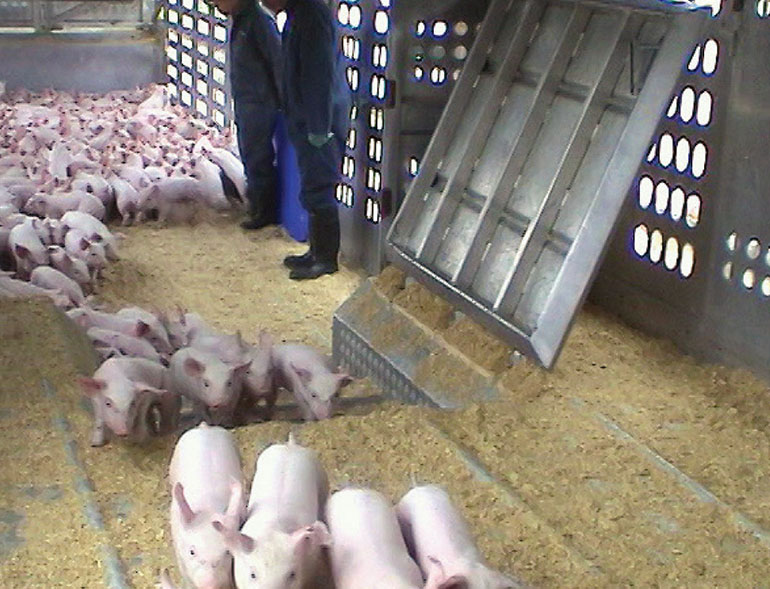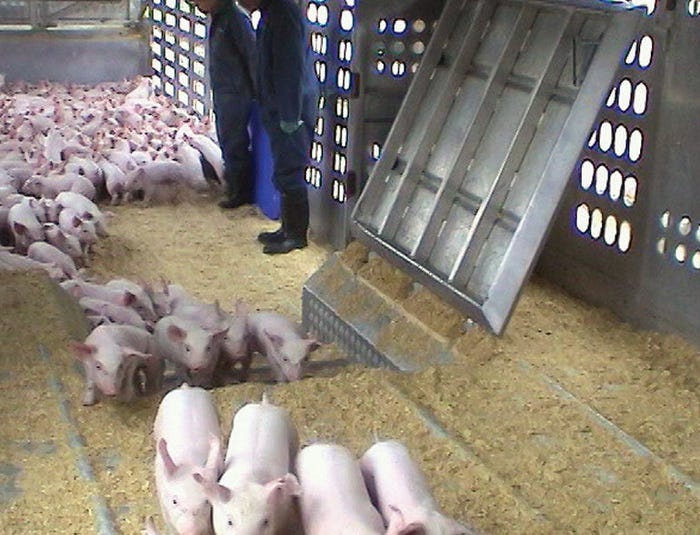Low-stress handling techniques show that moving pigs does not need to be a challenge.
September 13, 2017

Source: Zinpro Corp.
Moving pigs is often a time-consuming, frustrating and even hazardous process — but it doesn’t have to be.
Nancy Lidster knows that as well as anyone. She and her husband, Don, were commercial pig producers for 20 years in the Canadian province of Saskatchewan before spending the past two decades running a training company teaching best practices on pig handling techniques. “So many people are losing sleep because they are trying to move pigs in ways that don’t work and never will work,” Lidster says. “There also are a lot of people getting injured on farms because of their handling practices.”
Through their company, DNL Farms Ltd., Nancy and Don teach low-stress pig handling techniques. They emphasize that pigs move best when the animals feel safe and are allowed to move at their own pace.
Problems with old model
In many cases, the methods the Lidsters teach are the opposite of what people have long been taught. This is particularly true with aspects of the “flight zone/point of balance” model, which says the animals have a personal space, or flight zone, and will move to try to keep a handler out of that zone. In particular, it says pigs have a point of balance at their shoulders, and if a handler is behind that point, a pig will move forward. If a handler is in front of a pig, it will stop or back up. In other words, it says an animal will move away from a handler no matter how they approach it.
There are several problems with this, according to Lidster. First, the model was initially designed for a single cow moving through a curved chute — which over time evolved to show a single pig moving through that same curved chute. Pigs are often moved under other conditions where there’s nothing preventing them from turning around and nothing stopping a handler from getting into their blind spot. The model doesn’t say anything about the fact that a handler’s pressure — such as crowding pigs, physical contact and making noise to try to encourage movement in a certain direction, is often counterproductive.
“When a handler wants an animal to turn left, they’ll put a paddle or board on its right side assuming it will move away from it,” Lidster says. “In fact, that may draw the pig’s attention. Same thing with noise. If I am making noise behind a group of pigs, that draws their attention back.”
Low-stress techniques achieve ideal movement
Instead, the Lidsters teach low-stress pig handling techniques to help operations achieve a flowing herd behavior. Flowing means the pigs are calm, moving forward and driven by the movement of the other animals around them. The alternative is bunching, in which pigs are crowded, defensive and resist moving.
“To minimize bunching, handlers need to quit using fear and physical force to move pigs,” Lidster says.
In this ideal state of flowing, pigs are calm and their attention is forward. They are spaced out enough so as to minimize bumping into each other. There is nothing blocking or distracting pigs from forward movement. And the front animals are pulling movement while at the same time being driven forward by rear animals. A handler following behind needs to give pigs space and avoid crowding or distracting the rear animals (see Figure 1).

Figure 1: Handlers looking to achieve and maintain pig flow should remember to keep their paddles quiet (left photo) as this helps minimize noise and distraction for the pigs. The aggressive paddle technique (right photo) is included for comparison.
To feel safe, pigs need to be aware of their surroundings, be given time and space to move, be able to get release from pressures mentioned previously, and stay with other pigs. Signs that a pig is not calm include bringing its head and ears up and not paying attention to moving forward. “One of the most common mistakes by handlers is watching pigs’ butts instead of their heads, which is where they get the cues regarding fear and attention levels,” Lidster says.
Tips for handlers on what to do when pigs are becoming scared include:
• Pause and let the pigs move away
• Step back
• Soften body language
• Quit moving or making noise
• Allow the pigs to circle out of the handler’s pressure
Instead of a flight zone around pigs, the Lidsters teach handlers to think in terms of a bubble being around themselves, providing that safe space pigs need for optimal flow (see Figure 2). Positioning depends on the situation, but pigs tend to follow the arc of the handler’s bubble. When starting movement out of a pen, for example, if the handler stands reasonably close to the gate, then their bubble can act as a funnel to keep pigs moving to and through the gate.

Figure 2: Handlers can utilize the bubble surrounding themselves to help achieve flowing herd behavior.
“If instead the handler goes to the back of the pen, the pigs crowd the gate and stop because there’s only space for a few pigs to leave at a time,” Lidster says. “So now you’ve got them stopped, you’ve got them scared and they’re probably going to bunch at the gate or circle back within the pen.”
Real-world results show the value
When it comes to implementing low-stress pig handling, Lidster has this advice: It starts with training.
“Workers need be aware of what they should look for and the proper actions they should be taking,” she says. “They need to recognize the link between fear and handling problems.”
Improvement often comes quickly. She’s seen it at many of the operations that DNL Farms has worked with, as well as her and her husband’s own swine operation 20 years ago. “We quickly realized it doesn’t take much to get the pigs to flow properly,” Lidster says. “We started seeing results immediately.”
They also found that tasks that once required up to four people to complete could be accomplished by one or two workers. “It saved a lot of time and resources,” she says. “But the biggest thing was that we enjoyed it — we enjoyed working with the pigs and developing our skills.”
Zinpro has made improving swine wellness a focus through its Feet First program, which seeks to improve animal performance through lameness prevention and management. Nutrition plays a critical role in lameness prevention and Availa Sow, from Zinpro Performance Minerals, is specifically designed to help optimize foot health and reproductive performance. But it takes a comprehensive approach to have a significant effect. Low-stress pig handling is another factor in helping to decrease lameness and improve animal wellness and performance. To learn more from Nancy and Don Lidster about low-stress pig handling, visit LowStressPigHandling.com.
You May Also Like



